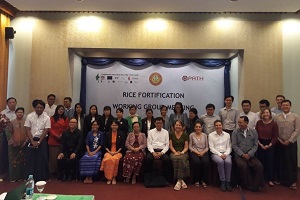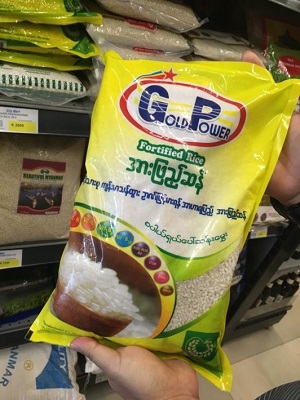 Special to the Philanthropy Journal
Special to the Philanthropy Journal
By Catherine May
The momentum to eradicate hunger and address all forms of malnutrition is growing across the world. Improved nutrition is a “vital precondition” to achieving 12 of the 17 Sustainable Development Goals[1]. Beyond that, the Global Nutrition Report reports that for every dollar invested in combating malnutrition, countries can expect to see a $16 return[2].
 Nowhere was this momentum more evident to me than in the Rice Fortification Working Group (RWFG) Meeting in Naypyidaw, Myanmar. Representatives from the public, private, and international donor sectors gathered to share their hopes and concerns for the future of fortified rice in Myanmar. Working with the PATH Myanmar office, I was there to learn how a policy could best support the two goals of the project: to reduce micronutrient deficiencies across the population while creating economic opportunities for suppliers and distributers.
Nowhere was this momentum more evident to me than in the Rice Fortification Working Group (RWFG) Meeting in Naypyidaw, Myanmar. Representatives from the public, private, and international donor sectors gathered to share their hopes and concerns for the future of fortified rice in Myanmar. Working with the PATH Myanmar office, I was there to learn how a policy could best support the two goals of the project: to reduce micronutrient deficiencies across the population while creating economic opportunities for suppliers and distributers.
PATH

December 2017 Rice Fortification Working Group Meeting in Naypyidaw, Myanmar. Photo courtesy of Catherine May.
For the past forty years, PATH has worked across more than 70 countries to address complex problems like malnutrition. PATH strives to save lives and improve health, especially among women and children, by advancing technologies, strengthening systems and encouraging healthy behaviors. Awarded the Conrad N. Hilton Humanitarian Prize in 2009, PATH’s health solutions now reach an average of 150 million people across the globe every year[3].
Much of PATH’s success can be attributed to their commitment to sustainable partnerships. Their flagship project in Myanmar is rice fortification to address multiple, population-wide micronutrient deficiencies. Starting in 2013, PATH worked to convene public, private, and social stakeholders to create a supportive policy environment, strengthen the supply chain and distribution, and generate sustained demand. This cooperation led the introduction of fortified rice in Myanmar on December 10, 2015 at the national level[4].
Why rice? Why Myanmar?
High reliance on rice in Myanmar has resulted in a typical diet that is low in micronutrients. Between 2011 and 2014, rice accounted for 73% of calories consumed, and 35% of food spending in poor households[5]. While it can provide sufficient calories, rice is already an inadequate source of iron, zinc, or vitamin A. The milling process further removes multiple B vitamins, folate, and dietary fiber[6].
The health impacts can be seen in high rates of stunting and anemia. An estimated 1.4 million children were considered stunted in 2016, and 47% of adult women were anemic[7]. While malnutrition affects the entire population, women and children carry the heaviest burden.
Rice fortification has the potential to address these problems by improving the nutrient quality of an existing staple food. It works by taking rice flour, combining it with vitamins and minerals, and reshaping the mixture into fortified kernels. These kernels are blended into regular rice, invisible to the consumer.
Next steps
Moving forward, there are still questions on how to best implement rice fortification efforts. At the production level, the equipment needed to make and blend fortified rice kernels isn’t cheap or readily available in Myanmar. This high, upfront investment precludes many small- and medium-sized millers from participating in rice fortification.
Further, the large millers that have procured this equipment are concentrated in the Ayeyarwady region, where much of agricultural rice production occurs. This will be good to meet the demands of the nearby urban centers with high population density. It will be a challenge to determine the best way to distribute fortified rice in rural areas, where agricultural productivity is comparatively lower and poverty is comparatively higher.
There are still concerns in sustaining demand. Beyond the third of the population that lives below the poverty line, another 14% is considered vulnerable to poverty[8]. Convincing households to spend extra on a new type of rice entails some level of risk in itself. Further, many of the health benefits of fortified rice aren’t readily visible. It takes six months of continued consumption to detect any changes.
Social Sector Can Build on Lessons Learned
The success of rice fortification in Myanmar relies on its ability to balance the tension between its two goals. From a public health perspective, it will be important to reach the households with the greatest need. From an economic development perspective, it will be important to create a viable marketplace that reliably provides fortified rice. The greatest obstacle to success for fortified rice can bring these perspectives together: it has to be affordable.
This is where collaboration among stakeholders is critical. Private businesses are still the primary source of investment in a food system[9]. The public sector can assure food quality and safety, distribute in social safety nets, or provide financial incentives such tax credits or consumer subsidies. Multilaterals and NGOs can ensure that Myanmar incorporates lessons learned from other fortification campaigns around the world.
PATH’s work to convene stakeholders and to leverage collective knowledge has led to an innovative product that can fit into Myanmar’s changing health landscape. As gaps between sectors narrow and collaboration deepens, the possibilities to reduce malnutrition and improve health in Myanmar will continue to grow.
[1] Scaling Up Nutrition. Nutrition and the Sustainable Development Goals.
[2] Development Initiatives, 2017. Global Nutrition Report 2017: Nourishing the SDGs.
[3] PATH. 40 years of impact.
[4] RWFG December 2017 Meeting Notes.
[5] World Bank Group, 2016 Rice sector development and poverty reduction in the greater Mekong subregion. Table 1: The importance of rice in GMS countries.
[6] [6] World Bank Group, 2016 Rice sector development and poverty reduction in the greater Mekong subregion.. Table 31: Macro- and micro-nutrients of rice.
[7] Myanmar Demographic and Health Survey 2015-216
[8] World Bank, 2017. An analysis of poverty in Myanmar.
[9] Haddad, L. GAIN. October 2017. Why isn’t there more research on public-private engagements in nutrition?
Catherine May completed her Hilton Prize Coalition Fellowship with the Nutrition Innovation team at PATH in 2017. She is now working toward her Master’s Degree in Public Administration at the Evans School of Public Policy & Governance at the University of Washington.





